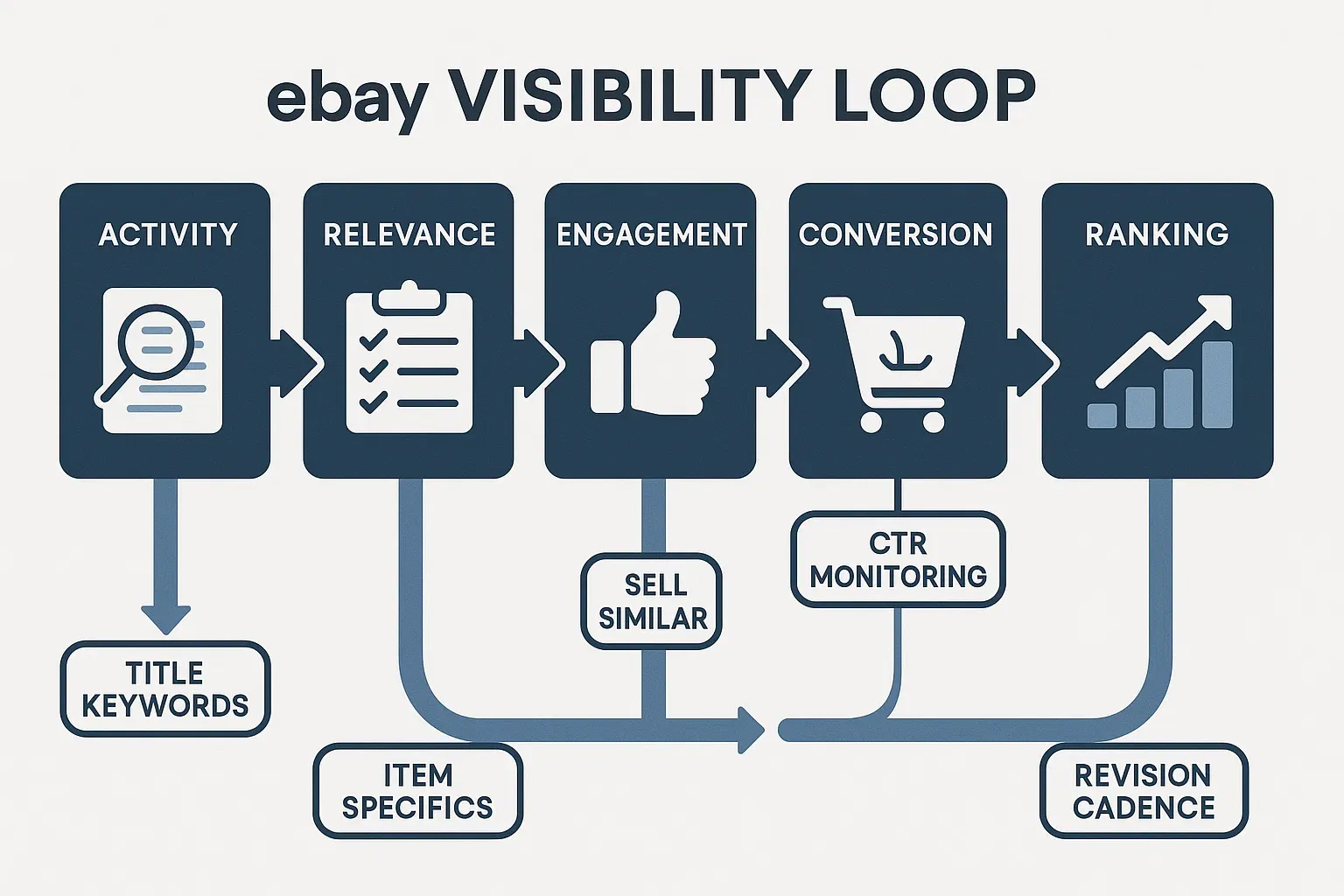Why Your eBay Listings Still Aren’t Getting Views (Common Mistakes & Myths Debunked)
Uncover the hidden mistakes holding back your eBay listings, despite optimization. Learn why freshness, communication, and Cassini strategy matter, backed by data and proven seller success stories.
June 12, 2025

Why Your eBay Listings Aren’t Getting Views in 2025: Myths and Fixes That Matter
“I’ve optimized my titles. I’ve got good prices. So why isn’t anyone clicking?”
If you've ever asked yourself that question, you’re not alone, and this article is for you.
What This Article Is About and Why It Matters
This is the third installment in our eBay visibility series. If you read How to Get More People to View Your eBay Listing and our follow-up, 10 Advanced Tips to Get More Views on Your eBay Listings (Follow-Up Q&A), you already know how essential impressions, click-through rate (CTR), and conversions are.
But what if you're still not getting the traffic you expected?
In this article, we're breaking down the most common myths and hidden mistakes sellers make, even experienced ones, and explaining why your listing might still be invisible to buyers. We’ll back it up with research, examples, and insights from sellers across every category, from collectibles to car parts to jewelry.
To start the series from the top, read How to Get More People to View Your eBay Listing
The Real Problem: Visibility ≠ Search Presence
Too many sellers assume that if their listing is live, it’s being seen.
But eBay’s search engine, Cassini, is far more complex. It favors activity, relevance, and conversion potential.
Many listings technically exist on the platform, but aren’t being surfaced at all, or are buried so deep that they may as well be invisible.

Common Myths Sellers Still Believe
“My item is live so that people will see it.”
Truth: Cassini limits exposure based on performance, listing age, and relevance.
“If I lower the price, it’ll start selling.”
Truth: Price is only one part of the equation. If your listing doesn’t look trustworthy or relevant, no discount will save it.
“It used to sell, so I’ll just wait.”
Truth: eBay treats stale listings as dead weight. If it hasn’t sold in 90+ days with no offers or watchers, it’s time to act.
For a deeper look at stale listings and resets, see Optimize Stale Listings on eBay: Proven Tips to Boost Visibility and Sales
How This Problem Got Started
When eBay first launched, it was an auction-driven platform. You’d list an item, add a decent photo, write a clear title, and buyers would find it. Search was chronological. Categories were basic. Competition was light. Most sellers were hobbyists, and if you refreshed your listings once a month, you were ahead of the game.
Over time, the platform evolved into a catalog-based platform, emphasizing relevance, conversion rates, and buyer trust. This shift left many sellers using outdated strategies, such as relisting items manually, keyword stuffing, or relying solely on price.
- Cassini replaced basic search: eBay’s current search engine prioritizes buyer intent, engagement signals, and behavioral data, not just who listed first.
- Seller volume exploded: With over 1.7 billion live listings today, it’s no longer enough just to be listed; you need to stand out and stay active.
- Buyers changed too: Today’s shoppers expect Amazon-level speed, trust signals, mobile-friendly design, and competitive pricing, all in one glance.
- “Set it and forget it” became outdated: Many sellers still operate under the myth that listing once and waiting works. It doesn’t. Algorithms now prioritize freshness, activity, and performance metrics.
The issue is that a lot of advice floating around (even on forums or YouTube) is still based on how eBay worked 10–15 years ago.
Some myths that got started back then, and still persist:
- “eBay resets your listings every 30 days.”
- “If you end and relist often, eBay will penalize you.”
- “The more keywords in your title, the better.”
These outdated strategies no longer apply in 2025. And many sellers, even experienced ones, are unknowingly hurting their visibility by following old rules.
The eBay algorithm (Cassini) is built to reward performance and relevance. If your item isn’t converting, it gets pushed down, no matter how perfect your title or how many watchers you have.
The Journey: From Side Hustle to Full Operation
For many eBay sellers, the journey begins with just a few items around the house, a side hustle built on extra time and curiosity. You list a phone case, some tools, an old camera, and to your surprise, it sells.
That first sale feels like a rush. So, you do it again. And again.
But somewhere between listing item #20 and your first 100 feedback, things shift. You stop thinking of eBay as a weekend project and start viewing it as a real business. You research what sells. You source inventory. You invest in tools. You care about performance.
Yet despite this evolution, something strange happens:
Your views plateau. Sales slow. You’re doing more, but getting less.
Why? Because many sellers carry beginner habits into advanced stages:
- Repeating titles and image styles from their first listings
- Ignoring changes in Cassini and buyer expectations
- Waiting for traffic instead of engineering it
This is where many sellers stall. They’ve graduated from hobbyist to business owner, but their approach hasn’t fully matured.
They might still:
- Upload in massive batches once a month instead of pacing uploads
- List without reviewing performance metrics
- Set-and-forget listings for months, even years. (We had sellers with listings from 2016, when the Chicago Cubs won their first World Series in 108 years)
- React to dips instead of planning around them
Transitioning from side hustle to full operation means embracing consistency, measurement, and adaptability. It’s not just about doing more, it’s about doing smarter.
Treat your eBay store like a storefront. Would you ignore your physical display for 90 days? Would you stop responding to walk-in customers? Would you refuse to update pricing even if demand changed?
If you want advanced tactics on timing and cadence, read 10 Advanced Tips to Get More Views on Your eBay Listings (Follow-Up Q&A)
Our Mission (Not a Sales Pitch)
Our team is made up of actual eBay Top Rated PowerSellers with real programming experience. We've been through every phase of this business, from flipping part-time in our garages to managing thousands of listings across multiple stores and selling millions in revenue.
Our goal is simple:
Take the guesswork out of eBay, so you can spend less time clicking and more time selling.
We’re not here to sell hype. We believe in tools that:
- Show you what’s working, and what’s not
- Automate your refresh cycles and relists
- Keep your listings visible without burning you out
Along the way, we discovered something frustrating:
Most third-party eBay tools are just inventory managers. They upload listings and prevent overselling; that’s it. And some don’t even do those two things well. (We know. We've tried nearly every one of them as sellers ourselves.)
So we built something different:
A platform focused on visibility, conversion, and long-term growth, not just logistics.
Whether you use us or not, we want sellers to win by working smarter.
Why These Myths Matter
These eBay myths aren’t just innocent misunderstandings; they shape how sellers run their business day to day. If you believe that eBay refreshes your listings automatically every month, you might stop revising them entirely. If you think all your active listings get viewed, you might miss major visibility problems. And if you assume your titles don’t influence your ranking, you could waste months wondering why sales have dried up.
Here’s why busting these myths is critical:
- Bad beliefs lead to bad habits.
If you build your workflow on outdated advice, you're leaving money on the table. - eBay rewards strategy, not luck.
Cassini (eBay’s algorithm) doesn’t care how long you’ve been selling; it rewards listings that are optimized, relevant, and active. Understanding what actually matters helps you work with the algorithm, not against it. - Stale listings = lost sales.
Believing myths like “eBay refreshes my listings monthly” or “if it hasn’t sold, it's because the price is high” causes sellers to ignore powerful tools like relisting, Sell Similar, and conversion optimization. - You waste time solving the wrong problem.
Instead of optimizing titles or images, sellers might keep lowering prices, or, worse, abandon the item entirely. - These myths spread fast in forums and groups.
Many new or struggling sellers pick up these myths from YouTube comments, Reddit, or Facebook groups, but those answers are often outdated, misunderstood, or based on edge cases.
Knowing the truth helps you take smarter actions, faster, and that’s what grows your store. Now, let’s fix that!
Backed by Data (Not Hype); We’ve run tests across hundreds of sellers, from $5 items to $100,000, across every major category.
Here’s what the data tells us:
- Stale listings (60+ days) without sales or edits drop up to 80% in impressions
- Listings revised every 45–90 days get significantly more visibility
- Over 70% of the low-performing listings we audited had missing or vague item specifics
- Sellers using "Sell Similar" every 60–90 days saw up to 3x more visibility than those who kept listings live indefinitely
Practical Mistake Fixes (That You Can Do Today)
Fix #1: Use Real Keywords, Not Fluff
Your title should include brand, model, color, and size, not vague words like “beautiful” or “amazing.”
- Bad Title: Beautiful Red Designer Heels – Size 7 – Like New
- Better Title: Jimmy Choo Red Suede High Heel Pumps Women’s Size 7
For more tips on writing better titles, check the section “Make Titles for Crawlers, Not for Humans” in our article How to Get More People to View Your eBay Listing.
Fix #2: Don’t Let Listings Rot
If your item hasn’t sold or received any offers in 60–90 days, end the listing and relist it using Sell Similar. This gives the listing a new item ID and reindexes it in eBay search.
Don’t relist your entire store in bulk; it can trigger penalties. If you have 500 listings, limit “Sell Similar” to about 25–50 per day (5–10% of your total inventory). Or better yet, use automation tools like MyListerHub to do it for you on a smart schedule.
Fix #3: Complete Your Item Specifics (All of Them)
Fill out key fields like:
- Size
- Brand
- Type
- MPN
- Condition
- Gender (especially for apparel and jewelry)
If a buyer uses filters and your listing is missing those specifics, you disappear from search, even if your item is relevant.
The more item specifics, the better. If you’re using AI tools to auto-fill them, always review before submitting. Incorrect fields can confuse buyers, lead to returns, or worse, negative feedback.
For more guidance, see “Fill Out Every Item Specific, And Then Some” in our article How to Get More People to View Your eBay Listing.
Fix #4: Monitor CTR and Adjust Accordingly
Use your traffic report to identify where things are breaking down:
- Low CTR: Tweak your title, price, or photo.
- High CTR but no sales: Improve your description, return policy, shipping, and buyer trust signals.
For hands-on automation that supports these fixes, explore Why eBay Sellers Should Automate Their Workflow
Why eBay Still Dominates (And You Shouldn’t Give Up)
Despite growing competition from Amazon, Etsy, Walmart, and other platforms, eBay remains a top-tier marketplace, and for good reason:
- One of the lowest selling fees in the industry
- No required ad spend, list and sell without paying for visibility
- eBay doesn’t compete with you by launching private-label products
- Easy to start selling, minimal red tape or onboarding hurdles
- Transparent feedback system that builds buyer trust
- Direct communication with buyers is a unique advantage
- Built-in “Offers to Buyers” and “Best Offer” tools that drive conversions
- Buyers can follow your store and get updates
- Offers authentication guarantees on luxury goods and collectibles
- Promotional tools like Coupons, Volume Discounts, and Promotions Manager
- The best platform for used, collectible, and one-of-a-kind items
- Still the #1 marketplace for jewelry, watches, car parts, vehicles, and fashion
- Unmatched global shipping program and cross-border reach
And if you want more, it has over 130 million members worldwide. But we prefer the word fans.

To connect visibility work with conversion gains, check Optimize Your eBay Listings and Increase Your Sales with MyListerHub
Experts vs. Sellers
We’ve reviewed dozens of YouTube guides, blog posts, and coaching content from so-called eBay experts. And we’ve noticed the same seller frustrations pop up again and again:
- “My sales keep dropping.”
- “I don’t see any major changes.”
- “I updated the title and it made it worse.”
- “I don’t know what part of my revisions is working.”
While some expert advice can help, much of it only covers surface-level tactics. What many miss is how Cassini actually works, like how often your listings are updated, how long they’ve been idle, or how your store’s overall activity affects ranking.
And not all advice is one-size-fits-all. What works for auto parts might hurt you in the jewelry category. What helps collectibles may backfire in fast-moving electronics.
This article was created to fill that gap, using real seller data, marketplace patterns, and hands-on experience, not just theory or templates.
Call to Action (No Pressure)
Want to track all your revisions, view CTR per item, and auto-refresh stale listings?
MyListerHub gives you a full activity history per SKU, so you can revise smarter, not harder.
✅ Track title and image edits
✅ Auto-schedule Sell Similar
✅ Spot dead listings before they hurt your store
But whether you use us or not, apply what you’ve learned.
Final Thought
If your listings aren’t getting views, it’s not because the market is dead; it’s because the algorithm isn’t convinced.